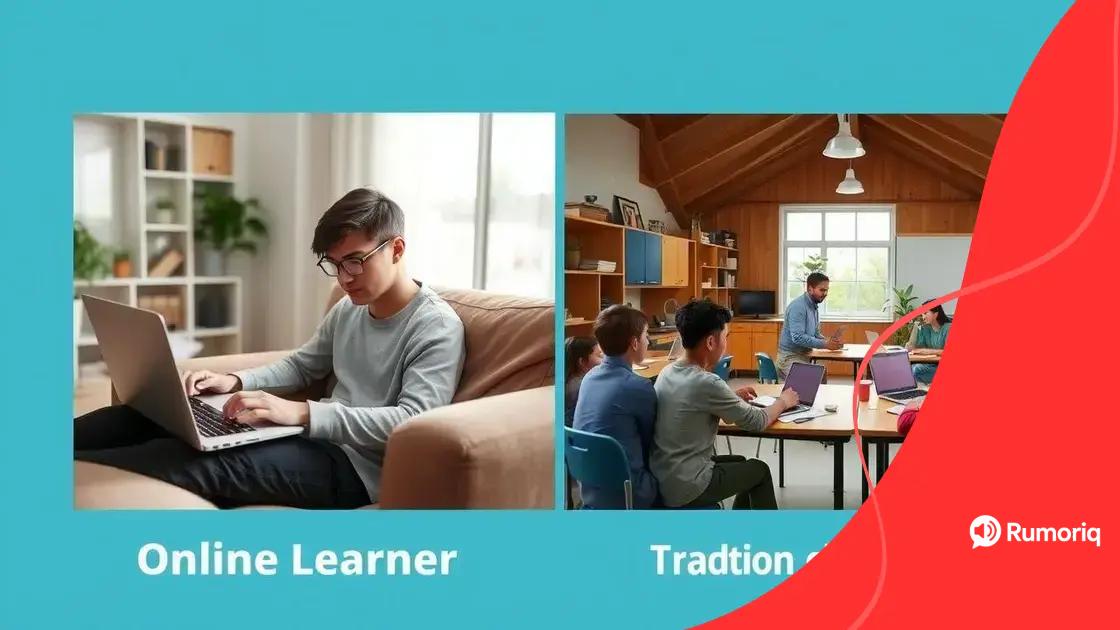Online education vs. traditional: Which is best for you?

Anúncios
Online education offers flexibility and accessibility, while traditional learning provides structured environments and direct social interactions, making each suitable for different student needs.
Online education vs. traditional methods often sparks debate. Each has unique benefits that can fit different learning styles. Have you ever wondered which one truly suits your needs?
Anúncios
Understanding online education
Understanding online education is crucial in today’s learning landscape. This method is reshaping how students access knowledge and interact with instructors.
Compared to traditional settings, online education offers unique advantages, such as flexibility and accessibility. Students can study from anywhere, whether at home or on the go, making it easier to balance responsibilities. This approach caters to diverse learning styles and paces, providing a customizable experience.
Key Features of Online Education
The components of online education include:
Anúncios
- Interactive Platforms: Many online programs utilize tools like video conferencing, discussion forums, and multimedia resources.
- Self-Paced Learning: Students often have the ability to set their own schedules and learn at their convenience.
- Global Access: Online education breaks geographical barriers, allowing students from various locations to enroll in courses worldwide.
- Diverse Course Offerings: A wide range of subjects is available, enabling students to pursue their interests or career goals.
Additionally, many platforms offer a mix of recorded lectures and live sessions, which cater to different preferences. Students can revisit recorded content as needed, reinforcing their understanding of complex topics.
However, online education requires self-discipline. The learning environment is often solitary, so students need to stay motivated and engaged. Time management skills become vital as they juggle coursework with other obligations.
Benefits of Online Learning
Some of the benefits of online education include:
- Cost-Effectiveness: Online programs often have lower tuition fees and save on commuting costs.
- Customizable Learning Experience: Learners can choose the courses that interest them and fit their career aspirations.
- Networking Opportunities: Online courses may provide access to a global community of learners and professionals, enhancing collaboration.
Understanding the dynamics of online education helps in making informed choices about how to pursue learning effectively. By recognizing its advantages and challenges, students can position themselves for success in this evolving educational environment.
Advantages of traditional learning
The advantages of traditional learning have long been recognized in educational circles. This method often provides a structured environment where students can thrive.
One of the main benefits is direct interaction with instructors and peers. This face-to-face communication fosters a collaborative atmosphere. Students can ask questions in real-time, deepening their understanding.
Key Benefits of Traditional Learning
Some of the standout advantages include:
- Structured Environment: Classrooms provide a dedicated space for learning, minimizing distractions that can occur at home.
- Immediate Feedback: Teachers can offer instant support and clarification, helping students grasp difficult concepts more efficiently.
- Social Interaction: Classroom settings encourage friendships and networking, promoting social skills that are vital in the workplace.
- Extracurricular Activities: Traditional schools often offer clubs and sports that enhance the educational experience beyond academics.
Furthermore, traditional learning often includes hands-on experiences, such as labs or workshops, which can deepen students’ practical knowledge. Students engage in discussions, enhancing their critical thinking and debate skills. Engaging with classmates through projects or study groups helps build teamwork abilities, essential for future work environments.
Yet, traditional methods also have their challenges. The rigid schedule may not suit every student, especially those with part-time jobs or family responsibilities. However, many still prefer the routine and discipline that these structures provide.
Academic Support and Resources
Another significant advantage is the access to resources:
- Libraries and Labs: Most traditional schools have libraries and laboratories that are essential for research and practical learning.
- Guidance Counselors: Students often have ongoing support for academic and personal guidance, which may not be as readily available online.
- Regular Assessments: Schools provide frequent evaluations, helping students track their progress and stay accountable.
While traditional learning may seem conventional, its advantages in fostering relationships, providing structure, and ensuring support can lead to a successful educational journey.
Comparing flexibility and accessibility

When comparing flexibility and accessibility in education, the differences between online and traditional learning become clear. Both offer unique strengths suited to various student needs.
Online education is lauded for its incredible flexibility. Students can choose when and where to study, allowing them to fit education around work, family, or other commitments. This flexible schedule empowers learners to progress at their own pace. Traditional learning, on the other hand, often follows a structured timetable that may not accommodate everyone’s individual circumstances.
Benefits of Flexibility in Online Education
The flexibility of online education allows students to enjoy numerous benefits:
- Self-Paced Learning: Students can accelerate their studies or take more time with challenging topics, catering to their unique learning speed.
- Remote Access: Learners can access course materials from anywhere, whether at home or while traveling.
- Customizable Schedules: The ability to attend lectures at different times lets students balance their education with other responsibilities.
While online education shines in flexibility, it may lack the hands-on experiences provided by traditional classrooms. For example, students in traditional settings attend lectures, labs, and participate in group projects, all of which are valuable for practical learning.
Accessibility in Traditional Learning
Accessibility also plays a vital role. Traditional classrooms provide a dedicated space for learning, which can be essential for students who thrive in social settings. They often create a community environment where learners can engage with peers and instructors directly. Moreover, many schools offer resources like libraries and counseling services, which enhance the support available to students.
In terms of accessibility, online education reaches a broader audience. Students from remote areas can enroll in programs that may not be available locally. This vast reach breaks down geographical barriers, allowing individuals worldwide to pursue their educational goals. However, reliable internet and technology access is necessary for online learning, which can be a hurdle for some.
Both modes of education present challenges regarding flexibility and accessibility. Some students may prefer the structure of traditional schooling, while others might thrive in an online environment. Understanding these differences helps learners choose the right path for their unique situations.
Costs associated with both forms
The costs associated with both online and traditional education can vary significantly. Each method comes with its own set of expenses that students and families should consider when making their decision.
Online education often appears more affordable at first glance. Many programs have lower tuition fees. Additionally, students save money on commuting, housing, and material costs. Institutions offering online courses may provide digital textbooks and resources free of charge, which also reduces expenses. However, it’s essential to factor in the expenses for reliable internet access and any necessary technology, such as computers or software.
Cost Breakdown for Online Learning
Here are some typical costs that students may encounter when pursuing online education:
- Tuition Fees: Often lower than traditional colleges, but can vary widely by program.
- Technology Costs: Expenses for a laptop, software, or other tech tools needed for online classes.
- Internet Access: Monthly fees for reliable high-speed internet service are necessary for attending online classes and accessing materials.
While these costs can be manageable, they still represent an important part of the overall financial picture.
Costs in Traditional Learning
In contrast, traditional education often has a more comprehensive cost structure. It includes tuition, but also additional expenses such as:
- Transportation: Commuting costs can add up, especially for those who travel long distances to attend classes.
- Housing: Students living on campus may incur higher costs for room and board, which can be significant.
- Activity Fees: Many schools charge fees for access to facilities and campus events, which can increase overall costs.
Despite the higher costs associated with traditional education, many students find value in the hands-on experiences and social interactions it provides.
Ultimately, understanding the financial implications is key in the decision-making process for students choosing between online and traditional learning. Each student’s situation is unique, so weighing these costs against their personal and educational needs is vital for making an informed choice.
Future trends in education
Future trends in education are shaping how learning will look for generations to come. As technology evolves, so do the methods by which students receive knowledge and skills.
One emerging trend is the increased use of artificial intelligence and machine learning in educational settings. These technologies can personalize learning experiences, allowing students to learn at their own pace. Adaptive learning platforms assess individual progress and adjust the curriculum accordingly, making education more tailored and efficient.
Remote and Hybrid Learning Models
Another important trend is the growth of remote and hybrid learning models. Many institutions are now combining in-person and online instruction to provide flexibility. This approach allows students to benefit from the social interactions of traditional classrooms while also enjoying the convenience of online resources. Here are some advantages:
- Flexibility: Students can choose their preferred learning environment, balancing home study with classroom attendance.
- Widening Access: Hybrid models often bring education to more students, including those in remote areas.
- Enhanced Learning Tools: Online tools and resources can enrich the traditional learning experience, making lessons more engaging.
This combination of learning styles meets varying student needs and prepares them for a rapidly changing workforce.
Focus on Lifelong Learning
The emphasis on lifelong learning is another emerging trend. As industries evolve, workers will need to adapt by acquiring new skills continuously. Educational institutions are beginning to offer more adult education programs and online certifications to support this need. Lifelong learning encourages:
- Skill Development: Individuals can advance their careers by learning new technologies or methodologies.
- Career Shift Opportunities: Many people can pivot to new fields by gaining necessary qualifications.
- Community Engagement: Lifelong learning fosters a culture of curiosity and social responsibility.
As these trends continue to grow, the landscape of education will become even more dynamic. Incorporating new technologies will enhance learning experiences, making education more inclusive and accessible to everyone.
FAQ – Frequently Asked Questions about Online Education vs. Traditional Learning
What are the main benefits of online education?
Online education offers flexibility, accessibility, and personalized learning experiences tailored to individual student needs.
How does traditional learning contribute to social skills?
Traditional learning promotes social interactions through face-to-face communication, helping students develop teamwork and interpersonal skills.
What are some costs associated with online learning?
Costs for online learning may include tuition fees, technology expenses, and reliable internet access, but can be lower than traditional education.
How is the future of education evolving?
The future of education is focusing on technology integration, flexible learning models, and lifelong learning opportunities for students of all ages.